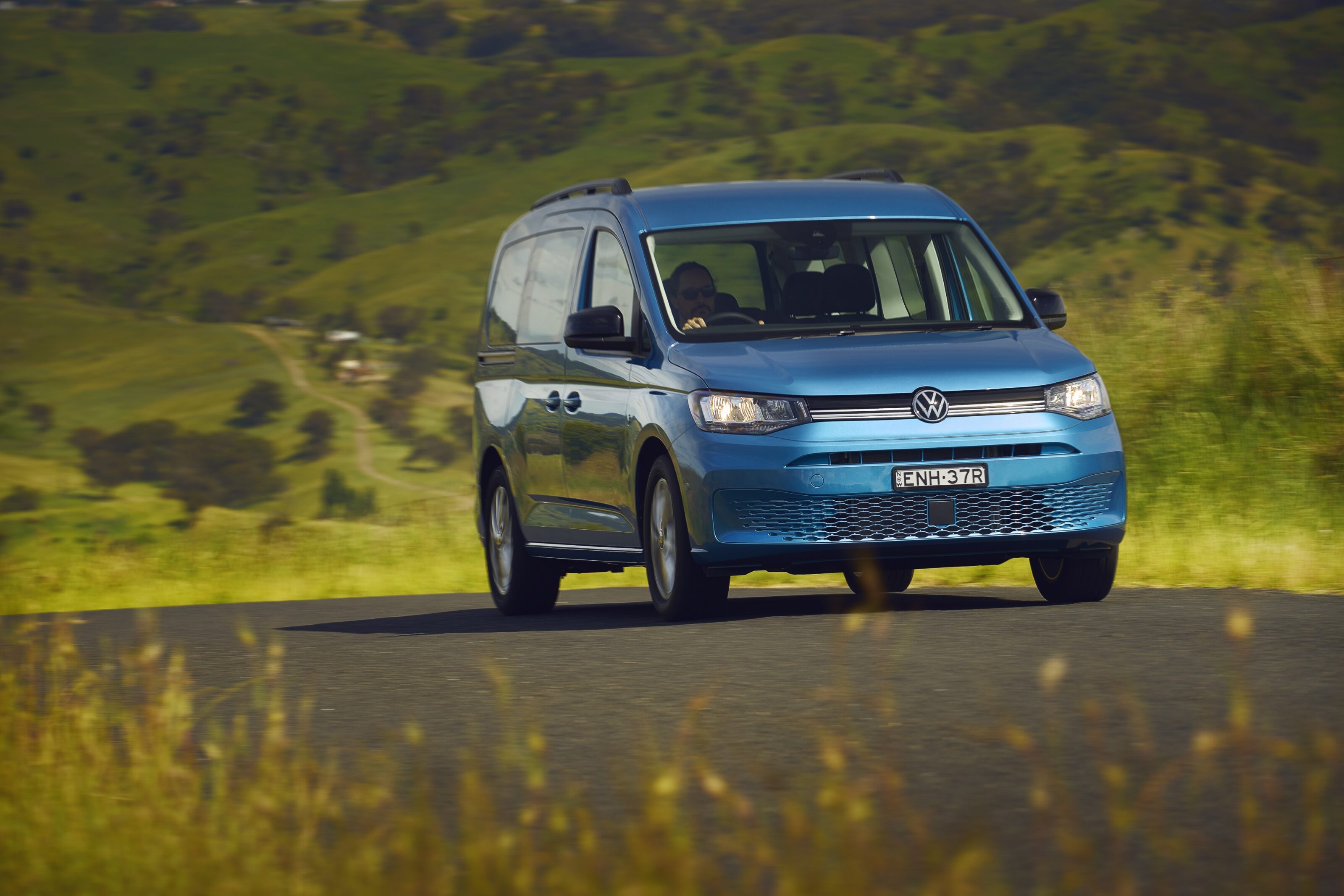Score breakdown
Things we like
- Some of the new colour palette
- Golf-ey tech
- MQB platform
- Safety package
Not so much
- Some of the new colour palette
- Hefty pricing
- LED headlights optional
Few things are as European as a city van. Spend time in a European city or even town and you can’t move for these things. I was once held up on the A9 between Glasgow and Inverness by a plumber’s Caddy doing 50mph in a 60 zone and then accelerating to 70mph when an overtaking lane appeared even though the road was covered in two inches of snow.
Anyway, the point is that they’re extremely popular and none more so in Australia than the Volkswagen Caddy. In 2019 before everything caught fire and then got sick, seven out of ten city vans sold in Australia were a Caddy. That’s extraordinary for any segment and while these vehicles aren’t as popular as bigger full-size vans (think VW’s own Transporter or the evergreen Hiace), that’s still a lot of vans.
That was then – Caddy 4 is no more. Caddy 5 is here and technically has been since August. But as things have been a mite tricky in recent months, it’s only now we’ve been able to get our hands on the new beastie in the new people mover spec, now known as Caddy.

Pricing and Features
Right. There’s a lot going on here and I don’t just mean the colours. Pricing for the Caddy 5 stretches from $34,990 for the short wheelbase Caddy Cargo petrol six-speed through to $57,690 for the as-yet-not-here Caddy California.
For the moment, the range stops just short of the Cali, with the DSG-equipped Caddy Life 320TDI people mover version.
Or at least, it will. You see during December, that $34,990 will buy you a diesel-powered manual Caddy Cargo until a price rise takes effect on New Year’s Day. This puts me in something of a bind because while the Caddy 5 has been available since August, there are already hefty price rises on the way and insertion of the petrol variants.
You could – with few people starting an argument – divide the Caddy 5 range into three distinct lines. So does VW, but I’ve made a couple of tweaks.
The first line is the full-on commercial city van, with the two-seat Caddy Cargo and five-seat Caddy Crewvan. You can read about them in my separate review next week. Available in short wheelbase and Maxi (long wheelbase) versions, you can get it with petrol and diesel options and with both manual and DSG transmissions.
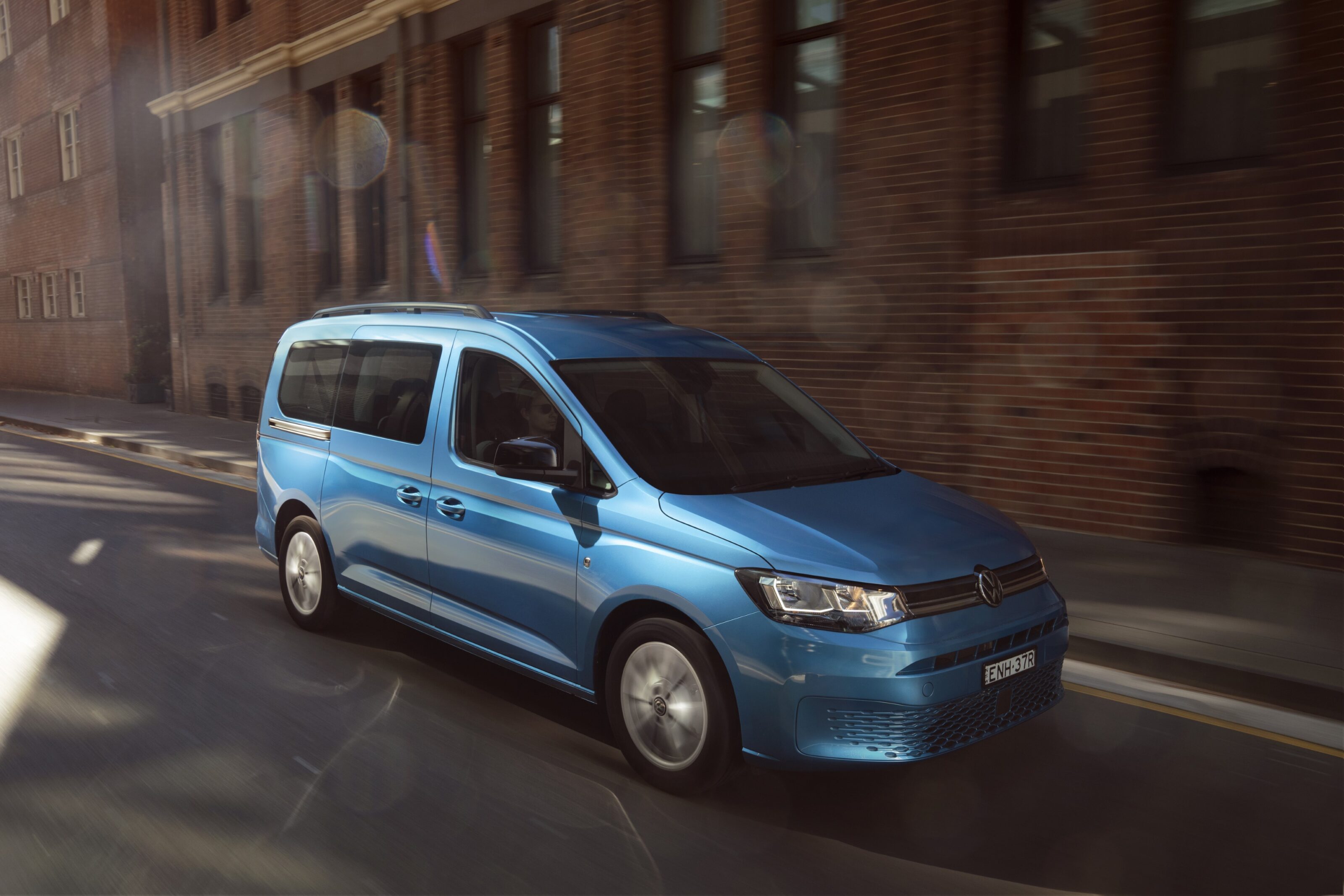
Jumping to the third category, we find the single spec California, which is a pure lifestyle camper-style vehicle that looks extremely cool.
The second is the mixed-use or dual-purpose line. Whereas the Cargo is all about Euro palettes fitting across the load area, the mixed-use ones throw in a second and third row of seats. All of these ride on the long-wheelbase Maxi version and for the moment, you can only choose diesel power. Unlike the Cargo, you can’t have a manual transmission.
The Caddy kicks you off with 17-inch steel wheels, colour-coded bumpers, cruise control, powered mirrors and windows, halogen headlights, remote central locking, cloth interior, carpet flooring, leather steering wheel, seven seats, air-conditioning and a full-size spare.
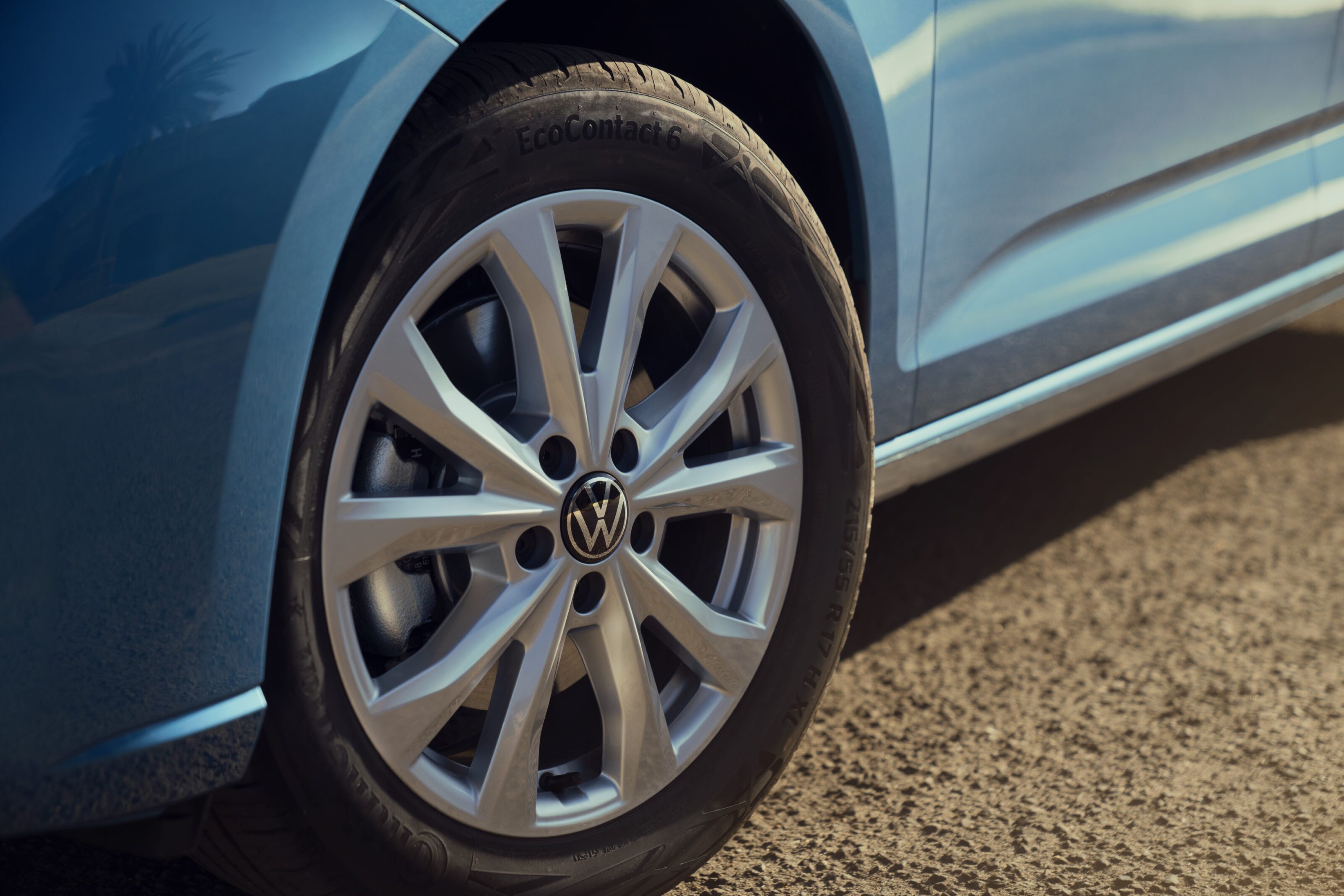
At the moment this car will cost you $45,490, equipped as it is with the 320TDI engine. From January, the range starts at $46,140 for the less torquey petrol, with the 320TDI rising to $48,150, meaning an on-the-road price over fifty grand.
The basic four-speaker entertainment system is called Composition and comes with an 8.25-inch touchscreen, DAB+ digital radio, Apple CarPlay and Android Auto and two USB-C ports for charging and connectivity. The VW software is very simple and it’s nice to use, although it does cram everything into the screen. Happily, a number of shortcut buttons mean that you can set your air-con or climate control (depending on the model) without having to trawl through menus.
If you step up to the $1660 Discover Media system, you get a bigger 10-inch screen, sat nav and wireless CarPlay and Android.
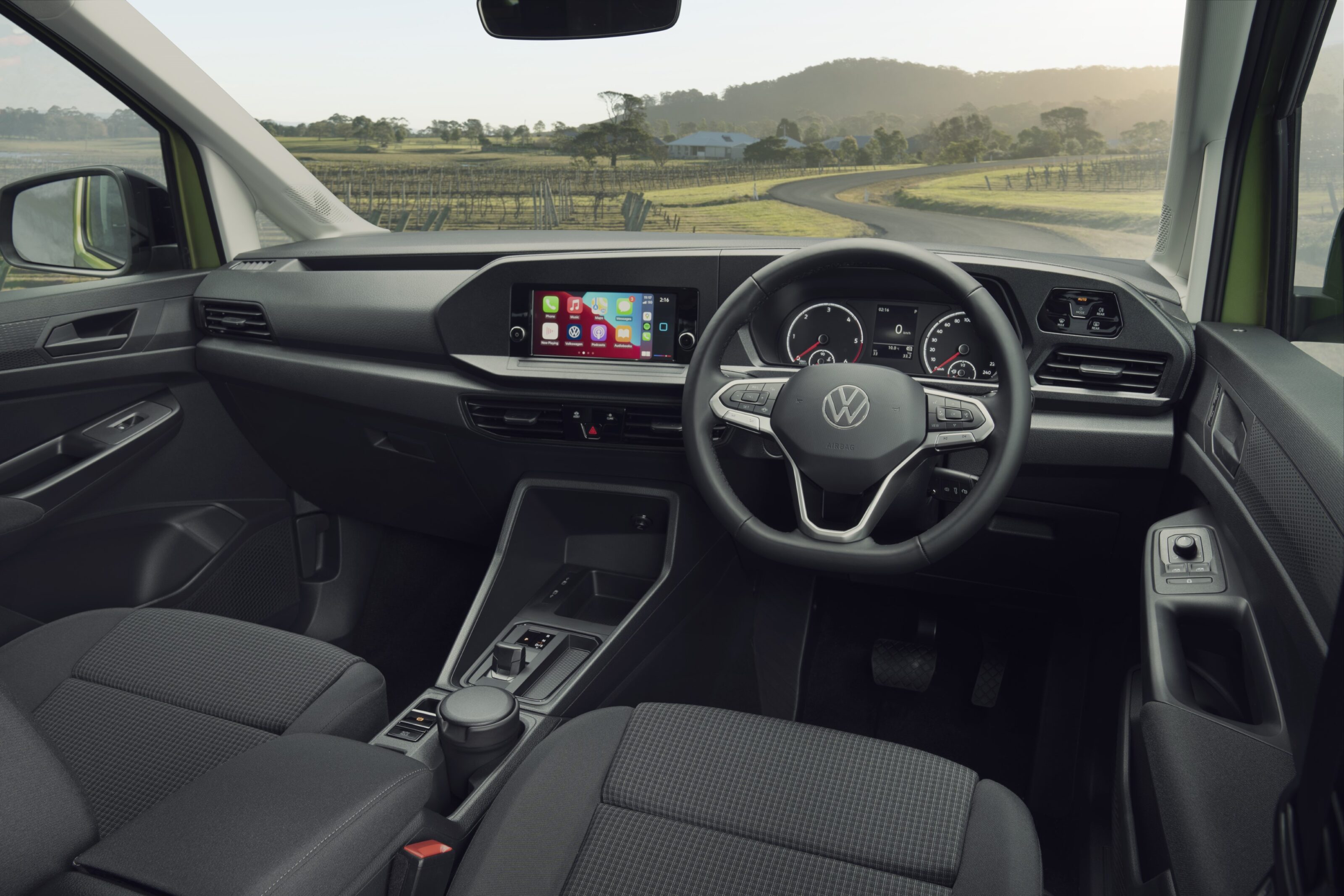
A big uplift in safety systems comes with a lot of airbags – front airbags, side airbags, curtain airbags and a front centre airbag to avoid head clashes in a crash. In these mixed-use Caddies, you pick up curtain airbags for all rows of available seating. You don’t even get that in a Kia Sorento or Hyundai Santa Fe.
On top of that you get the usual stability and traction controls, seat belt warning lights for all passengers, post-collision braking, forward AEB (low-speed with pedestrian and cyclist detection), drive fatigue detection, rear parking sensors, reversing camera, rear cross-traffic alert (hurrah!), lane change assistance, blind-spot monitoring, and junction assist.
The second row of seats includes three top-tether anchors and two ISOFIX points while both third-row seats feature ISOFIX and top-tethers.
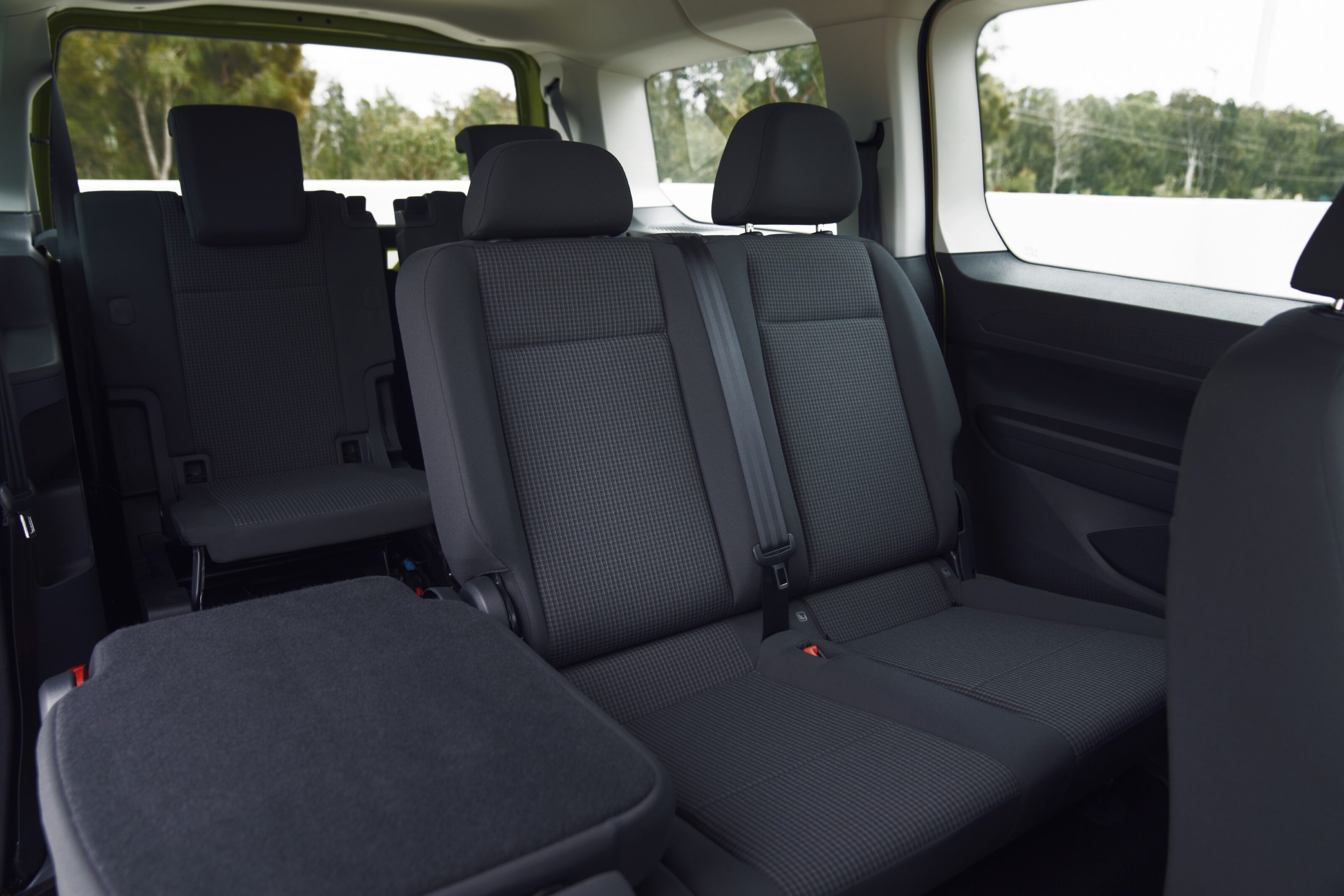
The Caddy 5 doesn’t yet have an ANCAP or EuroNCAP rating.
Moving up to the $49,990 Life and there’s more – 17-inch alloys, a bit of chrome here and there on the exterior, black roof rails, Trialog fabric trim, digital dashboard, heat-insulating front side windows, dual-zone climate control, front parking sensors, adaptive cruise control and a full-size spare.
Again, the price for the Life goes to $50,640 for the 84kW petrol and a hefty $2700 price for the 320TDI takes you to $52,640 before on-roads.
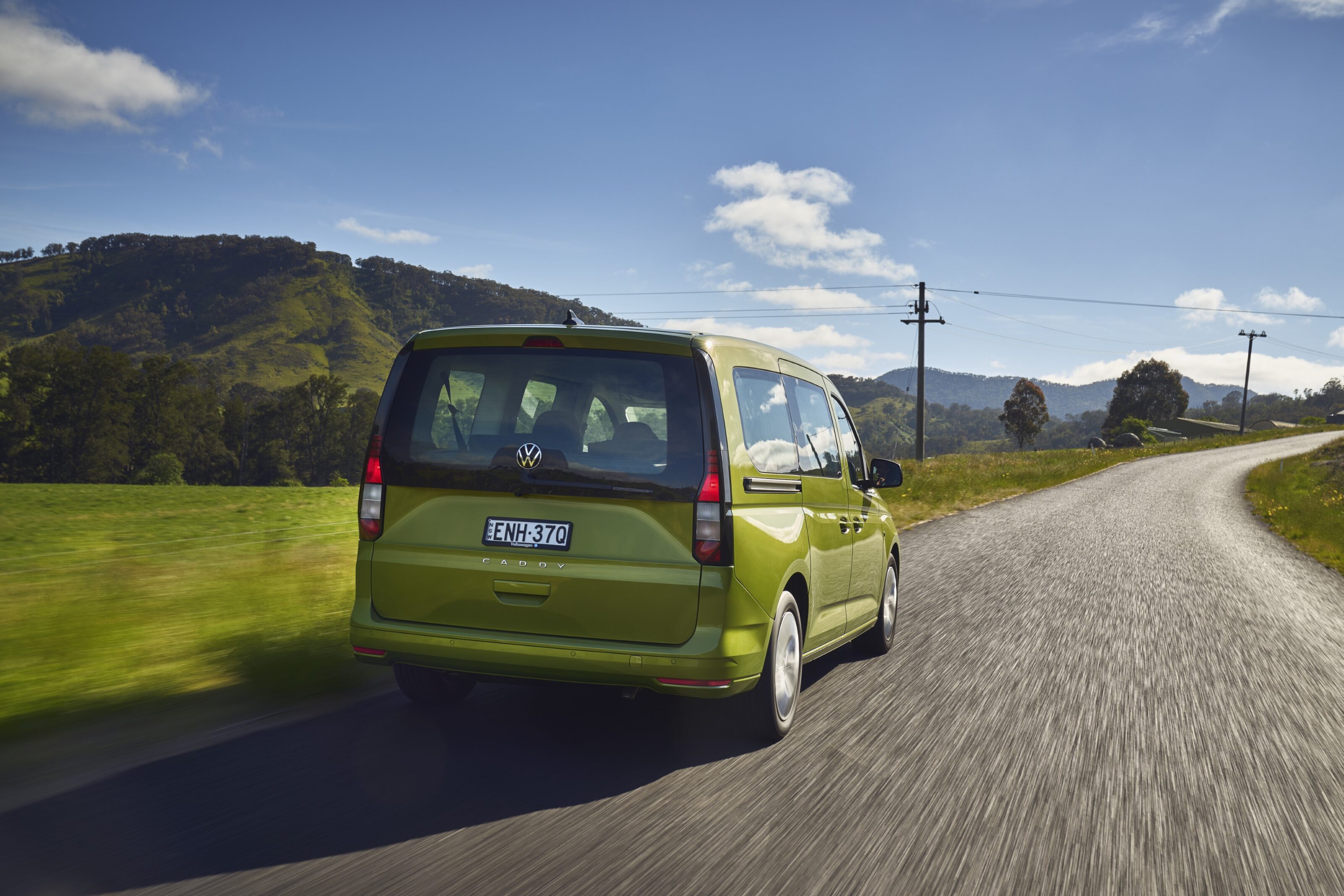
There are also a number of options available, as you might expect. The headliner (get it?) is the huge panoramic sunroof that opens up over the front and middle-row passengers. You can also specify comfort ventilation to push warm or cool air to the rear part of the cabin, but one wonders how effective that might be given the volume of the interior. Thankfully the Life has rear air vents for the middle row, which is a very important thing in my book.
LED headlights are also optional ($1370 or $2020 with LED DRLs and cornering lights) and the soft-close tailgate standard on the Life is an option on the Caddy, as are heat-insulating windows. There is a long and complex list of options to build your own Caddy so there’s lots of fun to be had and money to be spent.
You can choose from one free colour – Candy White – or two more solid paint finishes, Cherry Red and Pure Grey. Startlingly, there are seven metallic finishes: Reflex Silver, Mojave Beige, Costa Azul, Golden Green, Fortana Red, Indium Grey, Copper Bronze and Starlight Blue. The solitary pearl effect is Deep Black. Metallic and pearl colours are a terrifying $1115 while Cherry Red is a more reasonable $305.
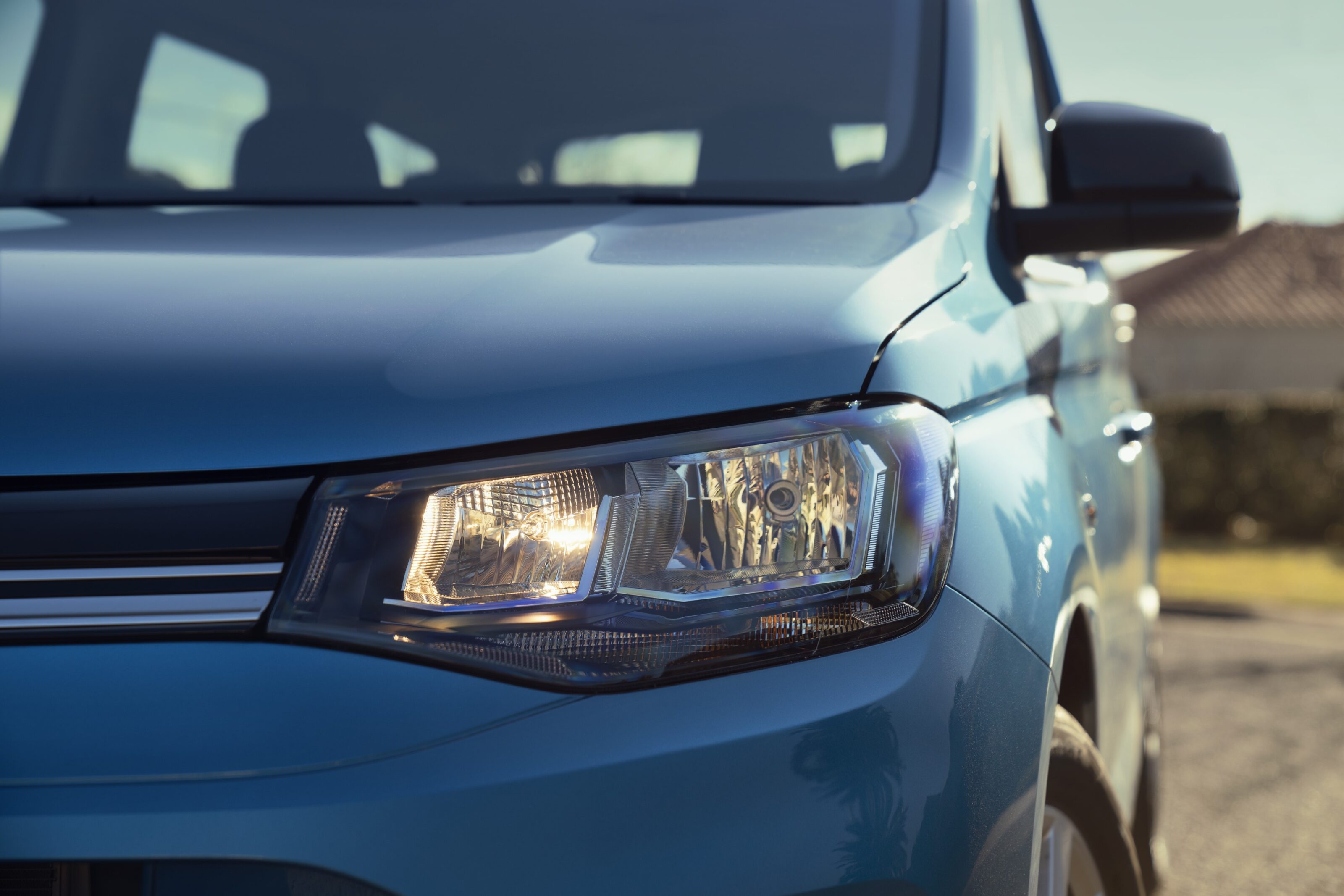
Comfort and space
As with most VWs, the Caddy and Life have a really nice, thoughtful approach to passenger space. There is more than adequate room in the middle row and outboard passengers even score folding airline-style tables which kids absolutely love. A friend’s son saw them in the Tiguan and declared them a “shut up and take my money” feature.
Storage is everywhere, a handy and serendipitous result of its tradie roots. The dashboard features a full-width slot for chucking bits and pieces. It widens as it crosses the car from left to right and you can fit a clipboard or iPad in the wider part of the slot over the instrument panel. If you don’t have the panoramic sunroof, there is further overhead storage where you can shove wallets and glasses cases, that kind of thing.
There are two cupholders in the centre front console and bottle holders in the doors. The middle row’s cupholders are in the tray table but won’t hold anything substantial or even a can of drink. They’ll have to go in the bottle holders in the doors or in the long storage pockets.

With all seven seats in place, access to the third row is a two-step process. Sliding doors on both sides open nice and wide and they’re light and easy to use. Grab the black tape at the base of the seatback to drop the backrest and then pull the red-trimmed tape to tip the whole unit up and forward. From there it’s an easy step to the rearmost two seats. The long sliding doors make it even easier to get in and the lofty roof means you won’t scrape your scalp.
Once you’re in, the third row once again shames some much bigger machinery. The two seats are jump seats with low seatbacks but adjustable headrests and you get a slim bottle holder, small cupholders and on the right-hand side a storage bin that would fit a first-aid kit. The seats are a little narrow, but they’re comfortable and the windows are big.
The middle row doesn’t slide but has good legroom and knee room. Headroom is galactic, literally so at night if you have the glass roof. It’s going to be tight three across, but the seats are comfortable and the cloth trim seems very hardy.
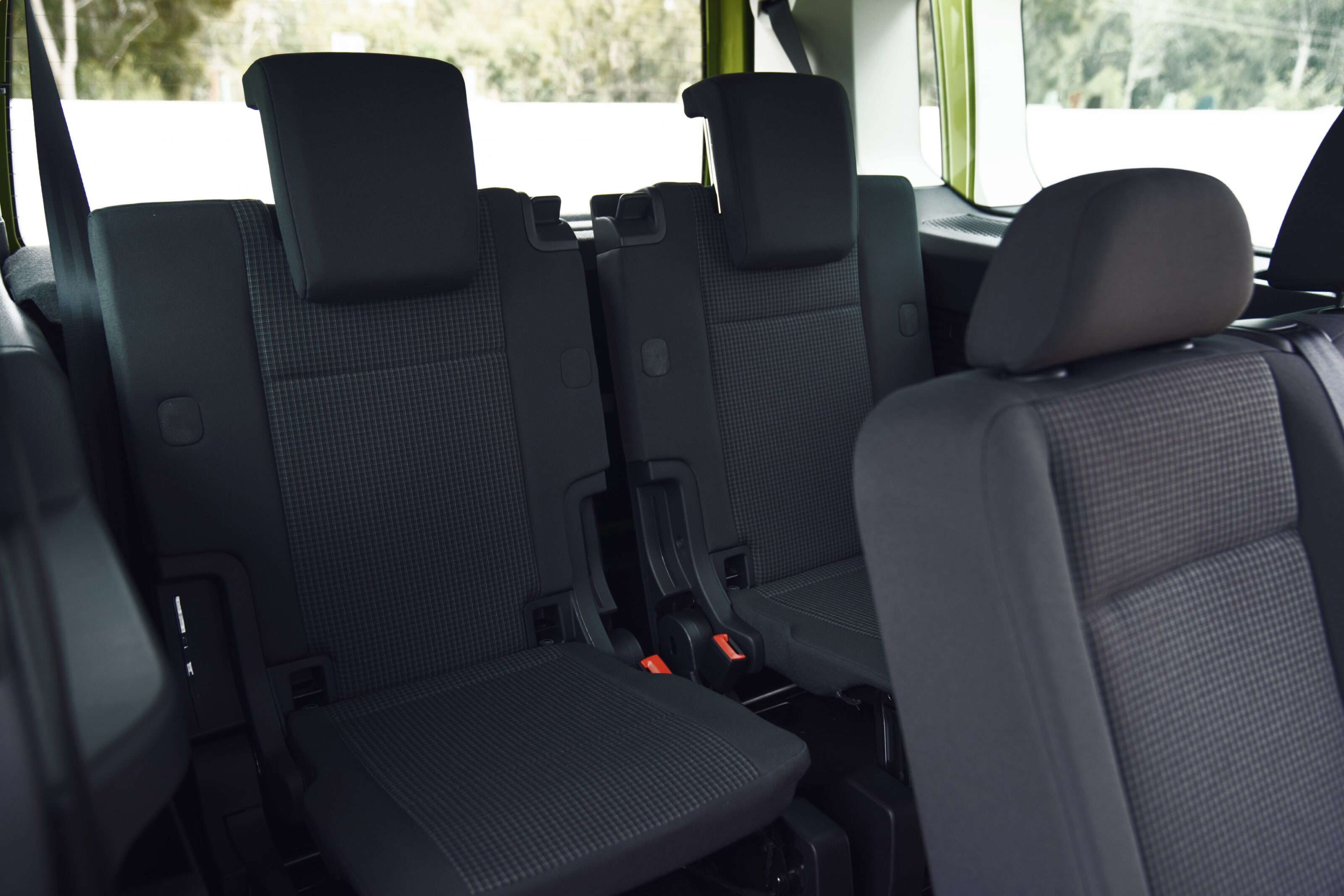
The boot is massive even with all three rows in place, shaming some much larger machines. You start with 446 litres, which matches plenty of mid-size SUVs. Remove the third row – not a moment’s work, but not a mission either – and you have 1720 litres.
Remove the 60/40 split-fold middle row and you have a gigantic 3105 litres, a flat floor of 2.265 metres’ length and an echo when you talk. A double airbed could go in there, no trouble. If your business is one of those party balloon suppliers, you’re in for a treat.
Sadly, there is some bad news – the windows in the passenger compartment don’t open. That’s where a van has its downsides.
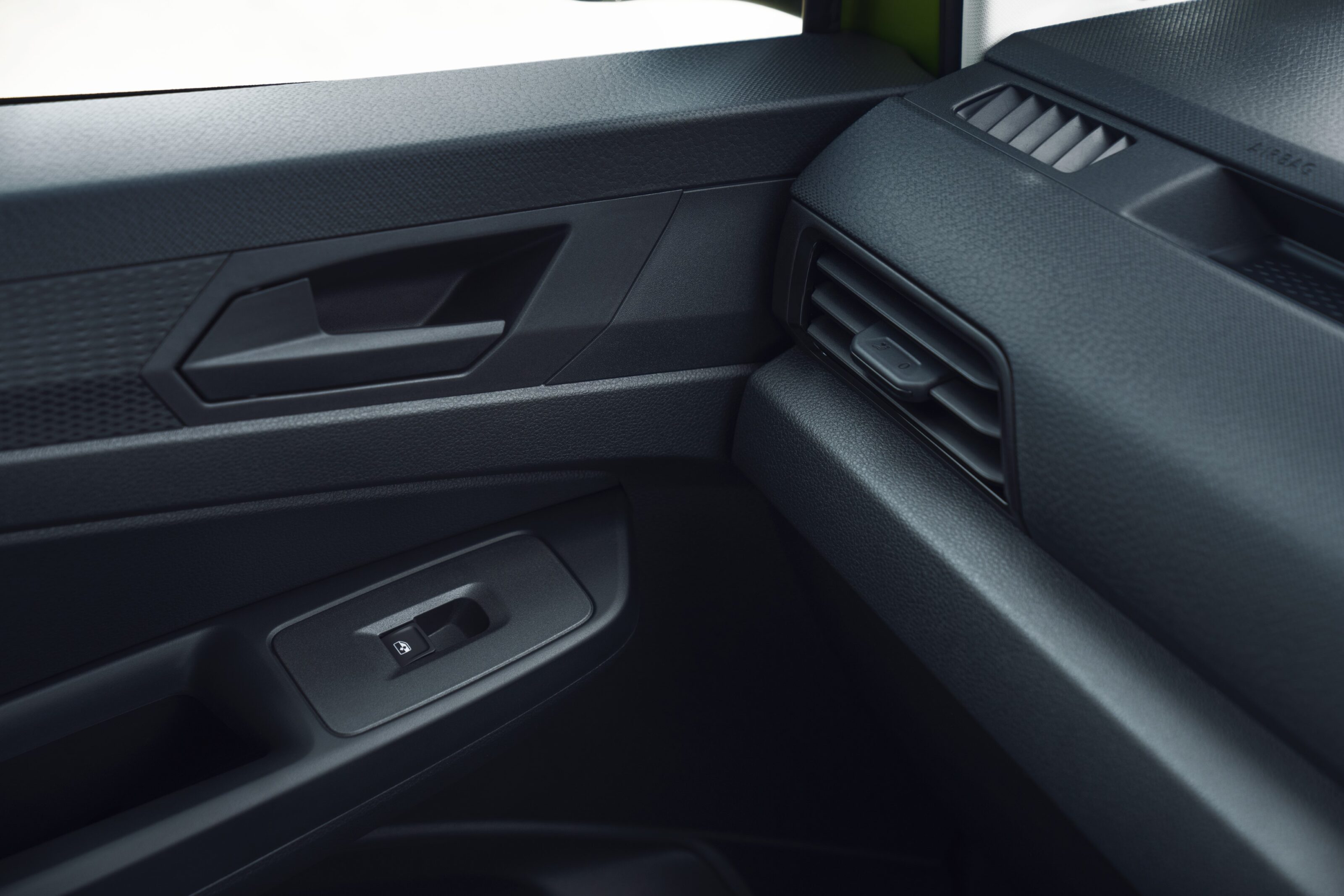
On the road
The Caddy Life I had for the week was the full-fat 2.0-litre turbodiesel TDI320 with 90kW and a thumping 320Nm of twist. It’s Euro VI compliant, so pretty clean by our (low) local standards.
The self-shifting TDI is rated at 4.9L/100km and my time with it, exclusively in the city as one might expect one of these vans to live, delivered a 6.2L/100km figure, which is good going. This engine features AdBlue, an additive that helps clean up NOx emissions endemic in diesel engines.
At the moment, all cars in the range are front-wheel drive although I’d be very curious to see if the all-wheel drive will eventually make its way here.
While the angle of the steering wheel yields a slightly awkward driving position, the seats had plenty of adjustment to reduce that level of awkwardness. The view out the massive windscreen is expansive and in this glass-sided passenger version with the panoramic sunroof, flooded with light. Remember your hats and sunglasses, sunroof or not.

My brief acquaintance with Golf VIII meant the cabin was already familiar. The funny stubby tongue poking out of the centre console acts as the gear selector and I really like it because it’s all that’s needed. You can also shift gears with the supplied paddle shifters and the leather-covered wheel is quite nice to hold and look at.
Quite honestly, if you never looked out the back, you’d think you were in a lightly stripped back Golf, except in this case there was the larger 10.25-inch screen over the 8.0-inch standard, making it feel less basic. Once you’re on the move, the Golf-ey feel remains but you feel the weight and relative long length of the Caddy.
This new car is built on the same basic platform as the Golf, the VW Group’s MQB. MQB sits under pretty much every front-wheel drive VW Group car – including the Golf to which I keep gratuitously referring – which means a fairly familiar driving experience. Grip at the front is good (yes, I know I’m talking about a van here) but the real benefit is the overall refinement.
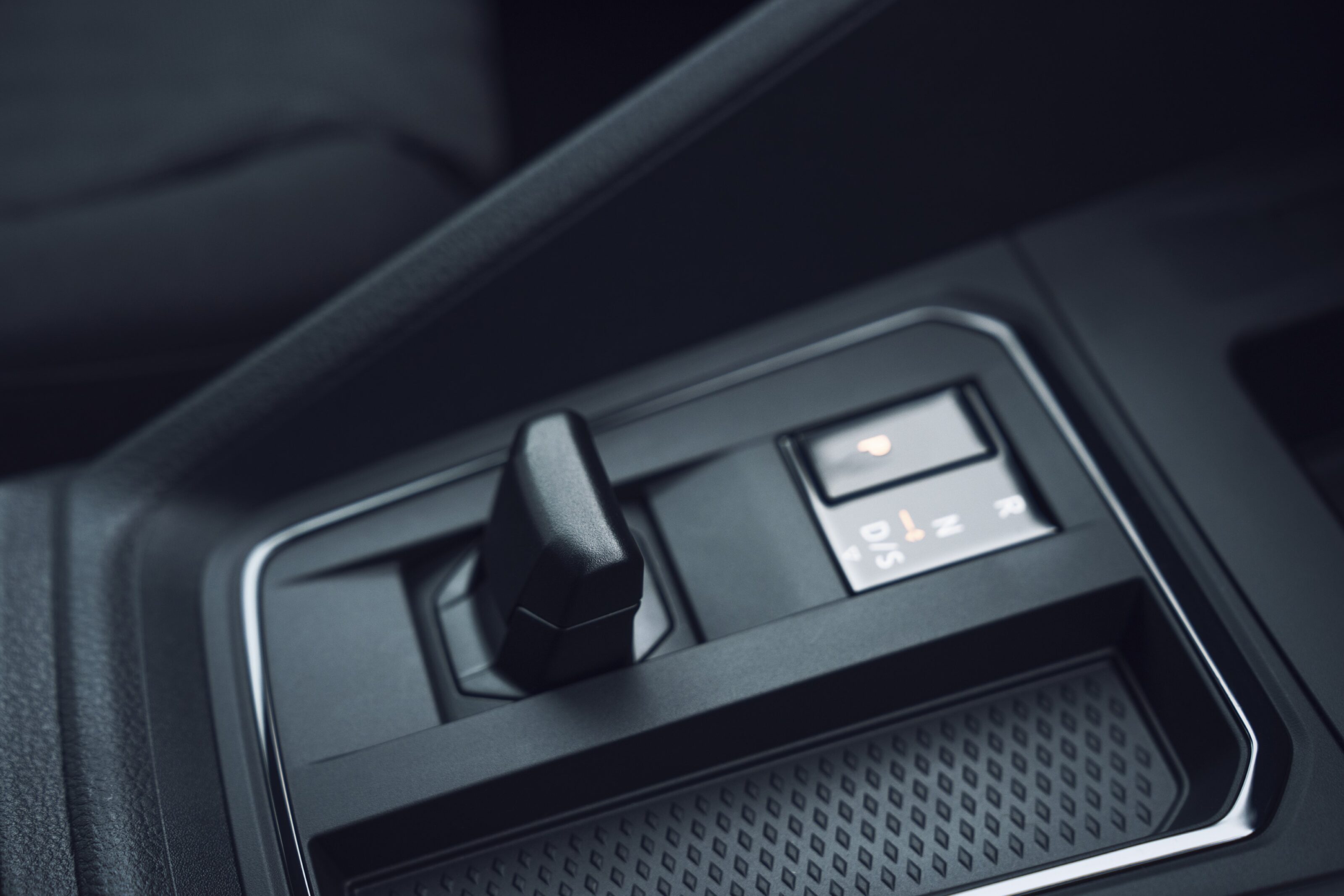
I like vans, they’re fun, especially this size machine. I drove a Peugeot Partner van about 12 months ago and I had a right old laugh bouncing around in it. The Caddy couldn’t be more different, with a car-like feel from the MacPherson strut front, the reasonably quick and responsive steering right through to the very car-like driving position.
Obviously, the Caddy’s weight and height are apparent, but the 2.0-litre does a great job of hauling things along at a decent if not amazing pace.
The rear end is held up by a very compact rigid axle with a Panhard rod, although now with coil rather than leaf springs.I was expecting the rear end to prove itself the real compromise for choosing a van-based people mover over a “proper” one like a Carnival or a SUV.
Despite the rigid axle, the Caddy handles speed bumps remarkably smoothly where I was expecting a bit of a jump. Obviously the coil springs help, as does the long wheelbase, but I found it incredibly smooth and unfussed by poor surfaces.
The safety systems are mostly pretty good, but the lane-keep assist is a bit pushy. Not Hyundai pushy, but pushy all the same. It’s kind of difficult to pick fault in the way the car drives because the trade-offs are worth it – huge headroom, true seven-seat capability and a passenger ride that a car of this type has no right to offer.
A friend who works in disability services also remarked in passing that the Caddy is a great car for to provide wheelchair access, which gives you an idea of how massive the space is.

Ownership
The Caddy comes with the same package as the “normal” car range, with a five year/unlimited-kilometre warranty and 12 months roadside assist.
VW offers two service packs. The first covers three years or 45,000km and costs $1300. If you pay as you go, VW reckons you’ll pay up to $265 more over the three services, so that seems like a handy saving.
If you choose the five year/75,000km package, you’ll pay $2100, saving up to $669 and getting the first service gratis.
As you can probably tell from these packages, VW expects to see you back for a service every 12 months or 15,000km, whichever comes first. These service figures compare favourably with the aforementioned Peugeot Partner and Renault Kangoo.
If you service with an official dealer, you’ll also get a 12-month extension on the roadside assist.
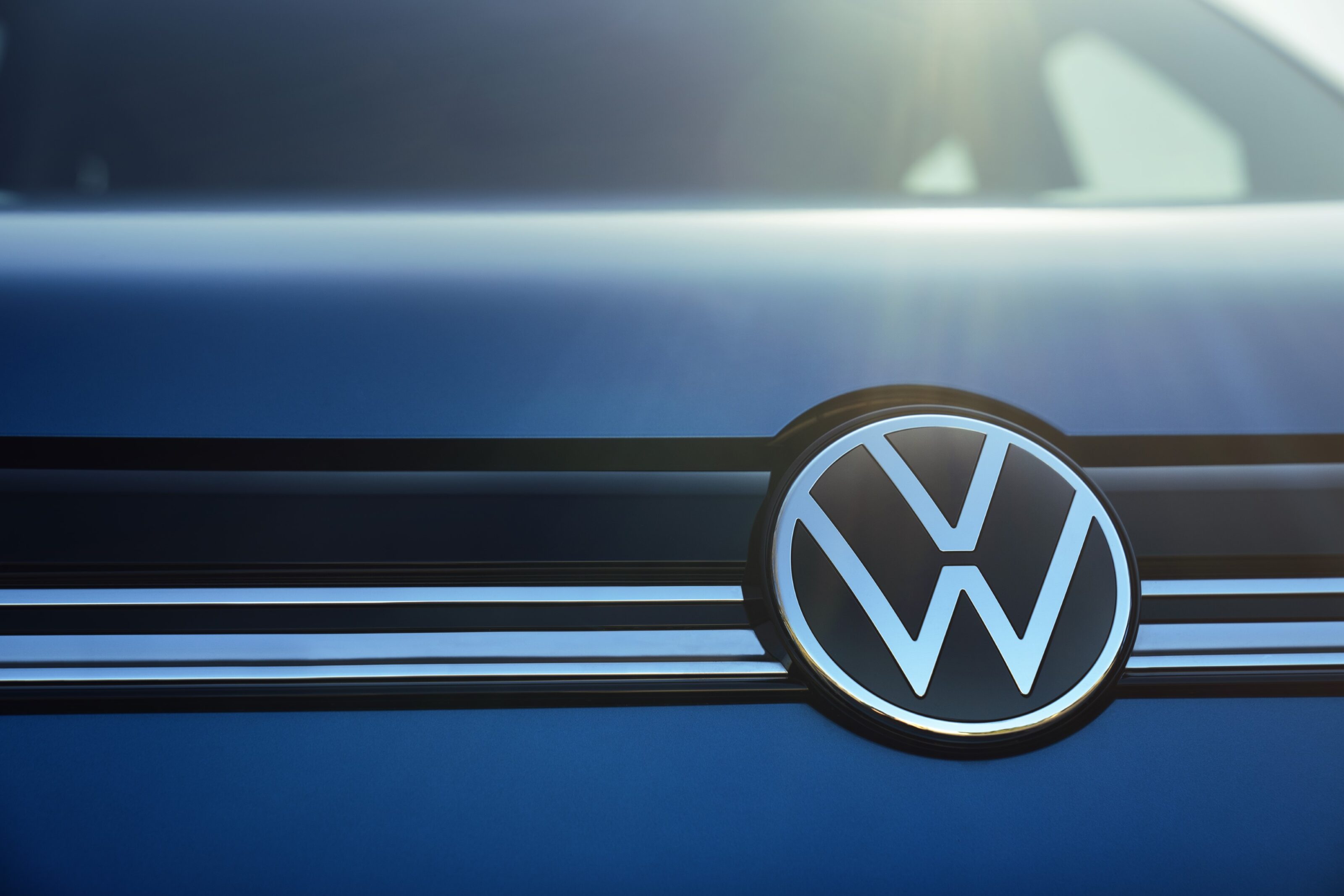
VERDICT
The Caddy 5 is a huge step up in basically every area. Technology, styling, passenger comfort, driving dynamics, the works. The only real room for improvement is perhaps electrification or a hybrid (although we know VW is more about full EV).
The comfort and refinement of this carpeted, glassed-in van with its high roof was a very pleasant surprise, but given the price, it will want to be this good.
Setting aside my faintly absurd fondness for vans, the Caddy 5 is quite an achievement. In this people mover version, you have a compelling proposition if you need a genuine seven-seat cabin without the cumbersome drama of a high-riding SUV or the bulk of a Carnival or Staria. It’s comfortable, refined and quite unlike any city van I’ve driven before.
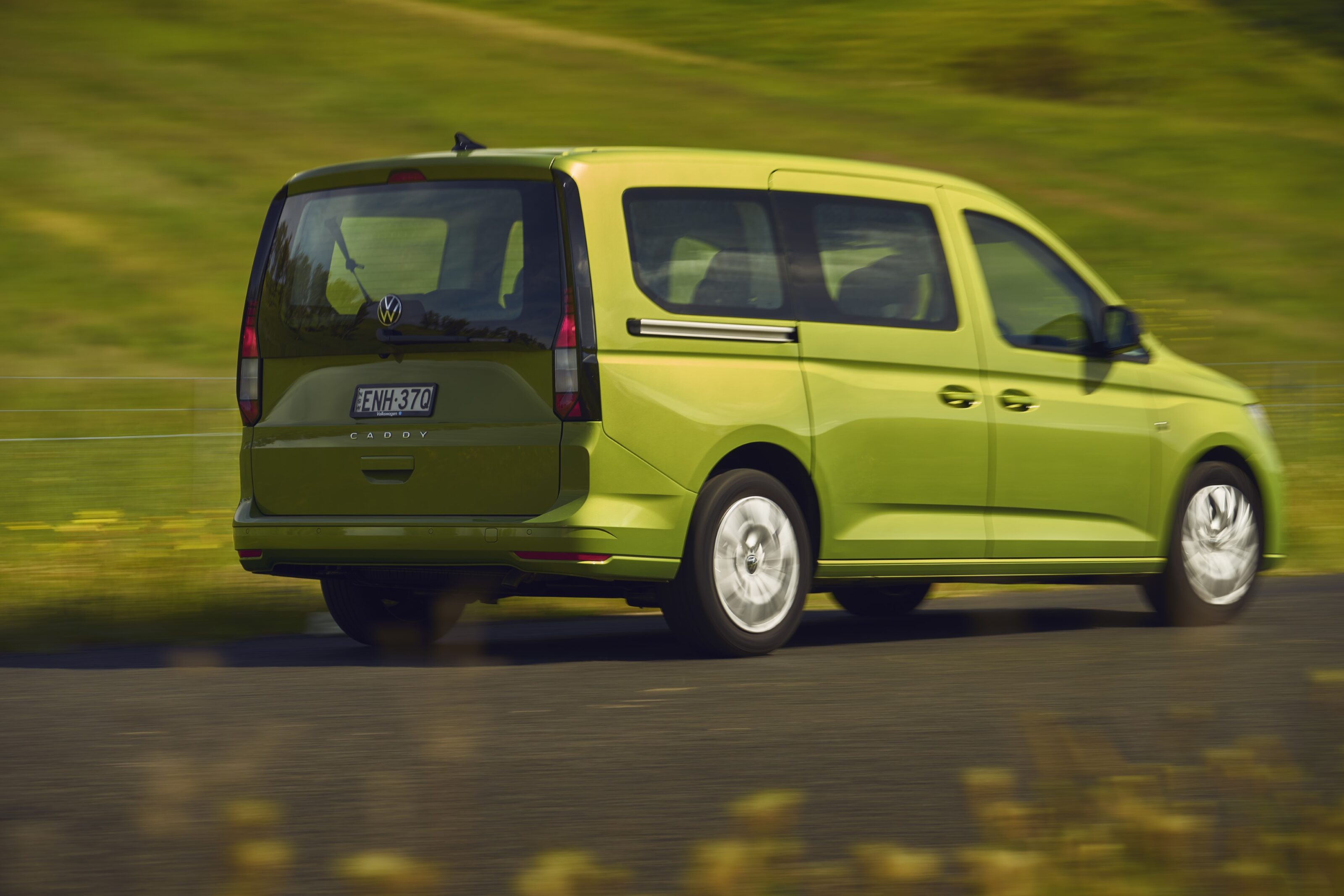
Volkswagen Caddy specifications
| Caddy Life | TDI320 | TSI220 |
|---|---|---|
| Body:u00a0 | Five-door seven-seat people mover | Five-door panel van/five-door people mover |
| Drive: | FWD | FWD |
| Engine: | 2.0-litre turbocharged four-cylinder diesel | 1.5-litre turbocharged four-cylinder petrol |
| Transmission: | Seven-speed twin-clutch | Seven-speed twin-clutch |
| Power: | 90kW @ 2750-4250rpm | 84kW @ 4500-6000rpm |
| Torque:u00a0 | 320Nm @ 1500-2500rpm | 220Nm @ 1750-3000rpm |
| Bore stroke (mm): | 95.5 x 81mm | 74.5 x 85.9 |
| Compression ratio:u00a0 | 16.0 : 1.0u00a0 | 12.5 : 1.0u00a0 |
| 0-100km/h:u00a0 | 11 sec (estimate) | 13 sec (estimate) |
| Fuel consumption:u00a0 | 4.9L/100km (combined) | 6.2L/100km (combined) |
| Weight: | 1740kg | 1667kg |
| Suspension: | MacPherson struts/Longitudinally guided rigid axle with Panhard rod | MacPherson struts/Longitudinally guided rigid axle with Panhard rod |
| L/W/H:u00a0 | 4853mm/1855mm/1856mm | 4853mm/1855mm/1856mm |
| Wheelbase: | 2970mm | 2970mm |
| Brakes:u00a0 | NA | NA |
| Tyres:u00a0 | 215/55 R17 Bridgestone Turanza | 215/55 R17 Bridgestone Turanza |
| Wheels:u00a0 | 17-inch alloy wheels (full-size spare) | 17-inch wheels (full-size spare) |
| Price:u00a0 | $49,990 (Nov 2021) $52,640 (Jan 2022) | $50,640+ ORC (Jan 2022) |
Score breakdown
Things we like
- Some of the new colour palette
- Golf-ey tech
- MQB platform
- Safety package
Not so much
- Some of the new colour palette
- Hefty pricing
- LED headlights optional


